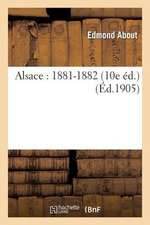Ethnic Minorities in 19th and 20th Century Germany: Jews, Gypsies, Poles, Turks and Others: Themes In Modern German History
Autor Panikos Panayien Limba Engleză Hardback – 8 feb 2016
During this long period German states were home to three different types of ethnic minorities in the form of- dispersed Jews and Gypsies; localised minorities such as Serbs, Poles and Danes; and immigrants from the 1880s. Taking a chronological approach that runs into the new Millennium, the author traces the history of all of these ethnic groups, illustrating their relationship with the German government and with the rest of the German populace. He demonstrates that Germany provides a perfect testing ground for examining how different forms of rule deal with minorities, including monarchy, liberal democracy, fascism and communism.
| Toate formatele și edițiile | Preț | Express |
|---|---|---|
| Paperback (1) | 539.27 lei 6-8 săpt. | |
| Taylor & Francis – 29 sep 2000 | 539.27 lei 6-8 săpt. | |
| Hardback (1) | 1009.74 lei 6-8 săpt. | |
| Taylor & Francis – 8 feb 2016 | 1009.74 lei 6-8 săpt. |
Preț: 1009.74 lei
Preț vechi: 1231.39 lei
-18% Nou
Puncte Express: 1515
Preț estimativ în valută:
193.21€ • 201.73$ • 159.91£
193.21€ • 201.73$ • 159.91£
Carte tipărită la comandă
Livrare economică 04-18 aprilie
Preluare comenzi: 021 569.72.76
Specificații
ISBN-13: 9781138139428
ISBN-10: 1138139424
Pagini: 304
Dimensiuni: 156 x 234 x 19 mm
Greutate: 0.73 kg
Ediția:1
Editura: Taylor & Francis
Colecția Routledge
Seria Themes In Modern German History
Locul publicării:Oxford, United Kingdom
ISBN-10: 1138139424
Pagini: 304
Dimensiuni: 156 x 234 x 19 mm
Greutate: 0.73 kg
Ediția:1
Editura: Taylor & Francis
Colecția Routledge
Seria Themes In Modern German History
Locul publicării:Oxford, United Kingdom
Public țintă
Postgraduate and UndergraduateCuprins
Chapter 1: Majorities and minorities in German history. Chapter 2: The emergence of the German nation state and the position of Ethnic minorities. Chapter 3: The Kaiserreich, 1871 - 1918: Prejudice, exploitation and full emancipation.
Chapter 4: A liberal interlude? The weimar Republic, 1919-33. Chapter 5: The triumph of the racists: nazism and its consequences. Chapter 6: The age of mass migration: Germanies after 1945. Chapter 7: The new Germany and its minorities. Bibliography. Index.
Chapter 4: A liberal interlude? The weimar Republic, 1919-33. Chapter 5: The triumph of the racists: nazism and its consequences. Chapter 6: The age of mass migration: Germanies after 1945. Chapter 7: The new Germany and its minorities. Bibliography. Index.
Notă biografică
Panikos Panayi is Professor of European History at De Montfort University and a leading authority on the history of immigration and ethnicity. His most recent book is the widely acclaimed Spicing Up Britain: The Multicultural History of British Food (2008, 2010).
Descriere
Taking a chronological approach that runs into the new Millennium, the author traces the history of all of the ethnic groups, illustrating their relationship with the German government and with the rest of the German populace. He demonstrates that Germany provides a perfect testing ground for examining how different forms of rule deal with minorities, including monarchy, liberal democracy, fascism and communism.
































